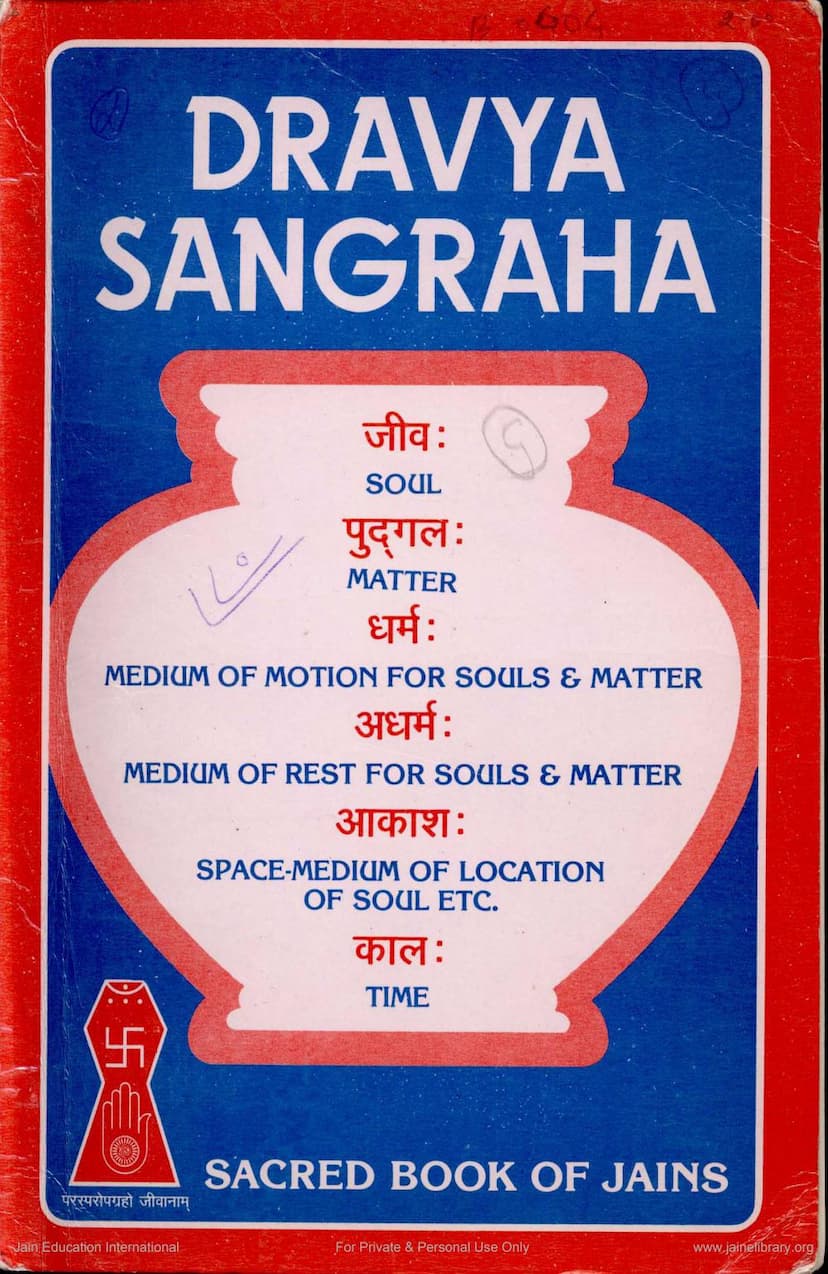Dravya Sangraha
Added to library: September 1, 2025

Summary
This document is a translation and commentary of the Jain text "Dravya Sangraha" by Muni Nemichandra. The book is a comprehensive exposition of Jain philosophy, focusing on the concept of "Dravya" (substance) and its categories.
Here's a summary of the key themes and concepts covered in the provided pages:
Core Jain Philosophical Concepts:
- Dravya (Substance): The universe is composed of substances, which are eternal and undergo modifications. The primary classification of Dravya is into Jiva (soul/living being) and Ajiva (non-living).
- Jiva (Soul):
- Characterized by Upayoga (consciousness or application).
- Formless (amutti).
- The agent (karta) of its actions.
- Equal in extent to its own body (sadehaparimano).
- The enjoyer (bhokta) of the fruits of karma.
- Exists in samsara (the cycle of birth and death) and can become siddha (liberated).
- Possesses an inherent upward motion (urdhva-gati).
- Possesses Jnana (knowledge) and Darsana (perception), which are distinct yet inseparable from the soul.
- Has eight types of Jnana (Mati, Sruta, Avadhi, Manah-paryaya, Kevala, and their Ajñana or incorrect forms) and four types of Darsana (Chakshu, Achakshu, Avadhi, Kevala).
- Is naturally formless but appears to have form due to karmic bondage.
- Possesses consciousness as its essential nature.
- Is associated with Punya (merit) and Papa (demerit) based on auspicious and inauspicious mental states (bhavas).
- Ajiva (Non-living): Consists of:
- Pudgala (Matter): Possesses form, color, taste, smell, and touch. It is the basis of the material universe and undergoes various modifications like sound, union, grossness, fineness, shape, darkness, light, and heat.
- Dharma: The medium of motion, assisting the movement of souls and matter.
- Adharma: The medium of rest, assisting stationary souls and matter.
- Akasa (Space): The medium that provides location for all substances. It is divided into Lokakasa (the universe) and Alokakasa (space beyond the universe).
- Kala (Time): Responsible for modifications and changes in substances. It exists as infinitesimal points.
- Five Astikayas: Jiva, Pudgala, Dharma, Adharma, and Akasa are called Astikayas because they exist (asti) and have multiple pradesas (spatial units), similar to bodies (kaya). Kala is not an Astikaya as it has only one pradesa.
- Seven Tattvas (Principles): The text introduces Asrava (influx of karma), Bandha (bondage of karma), Samvara (prevention of karma influx), Nirjara (eradication of karma), and Moksha (liberation). These, along with Jiva and Ajiva, form the seven fundamental principles of Jainism. Punya (merit) and Papa (demerit) are also discussed in relation to karma.
- The Path to Liberation: The ultimate goal is liberation (Moksha). This is achieved through the "three jewels" (ratnatraya):
- Samyak Darshana (Right Faith): Belief in the Jain tattvas.
- Samyak Jnana (Right Knowledge): Correct and detailed understanding of reality, free from doubt and error.
- Samyak Charitra (Right Conduct): Refraining from harmful actions and engaging in beneficial ones, characterized by vows, carefulness, restraints, observances, meditations, conquering troubles, and pure conduct.
- Meditation (Dhyana): Emphasized as crucial for achieving liberation. It involves fixing the mind, detaching from worldly desires, and focusing on the soul's true nature. Various levels and types of meditation are discussed.
- Pancha Paramesthis: The text identifies the five supreme beings (Arihanta, Siddha, Acharya, Upadhyaya, Sadhu) who are to be revered and meditated upon. Their characteristics are detailed.
Structure and Commentary:
- The book is structured with verses (shlokas) that are then explained through detailed commentaries.
- The commentary often clarifies the Jain perspective by contrasting it with other philosophical schools (like Sankhya, Nyaya, Buddhism, Charvaka) and explaining terms from both Vyavahara Naya (conventional or practical viewpoint) and Nischaya Naya (realistic or absolute viewpoint).
- The author, Muni Nemichandra, humbly acknowledges the possibility of imperfections in his work and requests correction from learned sages.
Overall Purpose:
"Dravya Sangraha" serves as a foundational text for understanding Jain metaphysics and ontology. It systematically explains the fundamental categories of existence and the path to spiritual liberation within the Jain tradition. The republished English version aims to make this vital Jain scripture accessible to a wider audience interested in its philosophical insights.